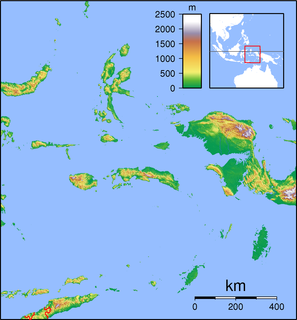
Waigeo is an island in West Papua province of eastern Indonesia. The island is also known as Amberi, or Waigiu. It is the largest of the four main islands in the Raja Ampat Islands archipelago, between Halmahera and about 65 kilometres to the north-west coast of New Guinea. The Dampier Strait separates it from Batanta, and the Bougainville Strait from the Kawe Islands to its north-west. The "inner sea" that nearly cleaves the island in two is the Majoli Gulf.

Erysichton is a genus of butterflies in the family Lycaenidae. The species of this genus are found in the Australasian realm.
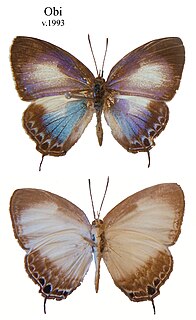
Hypochlorosis is a genus of butterflies in the family Lycaenidae. The species of this genus are found on New Guinea and in the Moluccas in the Australasian realm.

Luthrodes is a genus of butterflies in the family Lycaenidae erected by Hamilton Herbert Druce in 1895. Its species are found in Asia and in Oceania.

Zizeeria karsandra, the dark grass blue, is a small butterfly first described by Frederic Moore in 1865. It is found from the southern Mediterranean, in a broad band to India, Sri Lanka, the Andaman and Nicobar islands, Myanmar, Thailand, Malaysia, Yunnan, Indonesia, the Philippines, Arabia, United Arab Emirates, Saudi Arabia and Oman, New Guinea and northern and eastern Australia. It belongs to the lycaenids or blues family, and the tribe Polyommatini.
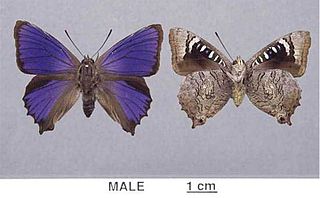
Ogyris is an Australasian genus of butterflies in the family Lycaenidae.

Philiris is a genus of butterflies in the family Lycaenidae. The species of this genus are found in the Australasian realm. Philiris was erected by Julius Röber in 1891. It is a speciose genus; Tite decided on 56 species, Sands added 11 species and placed the taxa into 21 species groups (broadly accepted by Parsons Most species are on New Guinea.Tite considered Philiris and Candalides Hübner, 1819 to be sisters. Eliot placed Philiris in Luciini Waterhouse & Lyell, 1914,

Allora doleschallii is a butterfly of the family Hesperiidae. It is found from Indonesia to the Solomon Islands, while subspecies Allora doleschallii doleschallii is found on the north-east coast of Australia.The name honours Carl Ludwig Doleschall.

Anthene seltuttus, the dark ciliate blue, is a butterfly of the family Lycaenidae. It is found in Australia, New Guinea, Indonesia and a number of bordering Pacific islands.

Hypolycaena phorbas is a butterfly of the family Lycaenidae. It is found in Waigeo, Biak, Roon Island, mainland New Guinea and various outlying islands as well as Australia.

Hypolycaena sipylus is a butterfly of the family Lycaenidae. It is widespread in Indonesia as well as occurring in the Philippines and the New Guinea region. It is the type species of the genus Hypolycaena.

Hypolycaena danis, the black and white tit or orchid flash, is a butterfly of the family Lycaenidae. It is found in the Maluku Province in Indonesia as well as the New Guinea region and north-eastern Australia.
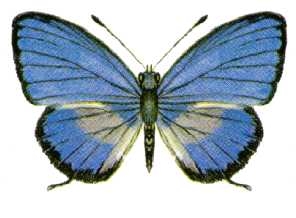
Nacaduba cyanea, the tailed green-banded line-blue, is a species of butterfly in the family Lycaenidae, and formerly considered a member of the genus Danis. It is found in the Indonesia, Papua New Guinea, the Solomon Islands and Australia (Queensland).
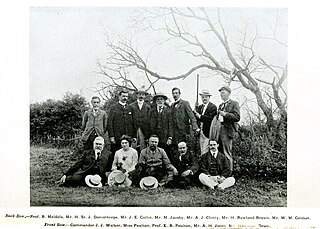
Hamilton Herbert Charles James Druce was an English entomologist who specialised in Lycaenidae and to a lesser extent Hesperiidae. He is not to be confused with his father, the English entomologist Herbert Druce (1846–1913) who also worked on Lepidoptera.

Jamides cyta, the pale cerulean, is a butterfly of the lycaenids or blues family. It is found throughout South-east Asia, from Malaysia to the Solomon Islands and the Philippines, as well as Queensland in Australia.

Hypochlorosis antipha is a butterfly in the family Lycaenidae. It is found on Maluku, Indonesia and Fergusson Island, Papua New Guinea.

Hypochlorosis lorquinii is a butterfly in the family Lycaenidae. It is found on Maluku and Fergusson Island.
Utetheisa ampatica is a moth in the family Erebidae. It was described by Rob de Vos in 2007. It is found in Papua New Guinea, where it has been recorded from the Raja Ampat Islands of Salawati and Waigeo.
Utetheisa pellex is a moth in the family Erebidae. It was described by Carl Linnaeus in 1758. It is found in New Guinea and surrounding islands, as well as in Australia (Queensland).

Pitt Strait (Indonesia), falls within the waters of the Indonesian province of West Papua. The strait separates the Raja Ampat islands of Batanta and Salawati and links the Ceram Sea to the Pacific Ocean. To its west lies Dampier Strait, which separates Batanta island from Waigeo island. The Sagewin Strait name refers to Sagewin Island, which lies at the south east side of Pitt Strait, close to Salawati.


















